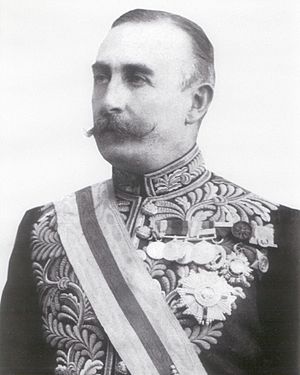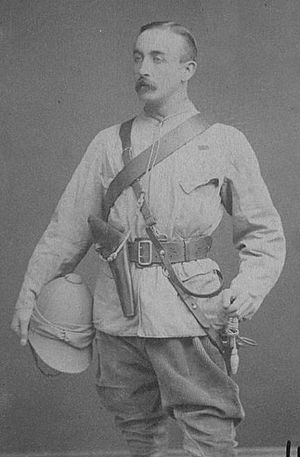Gilbert Elliot-Murray-Kynynmound, 4th Earl of Minto facts for kids
Quick facts for kids
The Earl of Minto
|
|
|---|---|
 |
|
| 17th Viceroy and Governor-General of India | |
| In office 18 November 1905 – 23 November 1910 |
|
| Monarch | Edward VII |
| Prime Minister | Arthur Balfour Henry Campbell-Bannerman H. H. Asquith |
| Preceded by | The Marquess Curzon of Kedleston |
| Succeeded by | Charles Hardinge, 1st Baron Hardinge of Penshurst |
| 8th Governor General of Canada | |
| In office 12 November 1898 – 10 December 1904 |
|
| Monarch | Victoria Edward VII |
| Prime Minister | Canadian • Wilfrid Laurier British • The Marquess of Salisbury • Arthur Balfour |
| Preceded by | The Earl of Aberdeen |
| Succeeded by | The Earl Grey |
| Personal details | |
| Born | 9 July 1845 Mayfair, London, UK |
| Died | 1 March 1914 (aged 68) Minto, Scotland, UK |
| Spouse | Mary Caroline Grey |
| Children | 5 |
| Parents | William Elliot-Murray-Kynynmound, 3rd Earl of Minto Emma Hislop |
| Alma mater | Trinity College, Cambridge |
Gilbert John Elliot-Murray-Kynynmound, 4th Earl of Minto (born July 9, 1845 – died March 1, 1914), was an important British politician and noble. He was known as Viscount Melgund for many years before he became an Earl. He served as the Governor General of Canada, which is the Queen's or King's representative in Canada. He was the eighth person to hold this role since Canada became a country. Later, he became the Viceroy and Governor-General of India, which was the top British official in India. He was the 17th person to hold that position.
Contents
Early Life and Career
Gilbert John Elliot-Murray-Kynynmound was born in London. His father was the 3rd Earl of Minto, and his mother was Emma Hislop. When his grandfather passed away in 1859, Gilbert became known by the special title of Viscount Melgund. This was a "courtesy title" given to the eldest son of an Earl.
He studied at Eton College and Trinity College, Cambridge. After his studies, he joined the Scots Guards as a Lieutenant in 1867 but left in 1870. He then joined a volunteer military group.
Gilbert was very adventurous. In 1874, he worked as a newspaper reporter and saw fighting in Spain. He also served with the Turkish army during a war with Russia in 1877. He even served in the Second Anglo-Afghan War (1878–1879).
In 1881, he worked for Lord Roberts in South Africa. He was also with the army in Egypt in 1882. These experiences helped him learn about military life and how colonies were managed. He was promoted to Major in 1882.
From 1883 to 1885, he was a military secretary to the Governor General of Canada, the Marquess of Lansdowne. During this time, he lived in Canada with his wife, Mary Caroline Grey, whom he married in 1883. While in Canada, he helped create a Canadian volunteer force to serve with the British Army. He also served as Chief of Staff during the North-West Rebellion in 1885. He was offered command of the North-West Mounted Police (now the RCMP), but he decided to try a political career in Britain instead. When he left Canada, the Canadian Prime Minister, Sir John A. Macdonald, reportedly told him, "Some day Canada will welcome you back as Governor General."
Gilbert tried to become a Member of Parliament in 1886 but lost the election. After that, he focused on promoting a volunteer army in Britain. In 1888, he became a Colonel. In 1891, his father died, and Gilbert became the 4th Earl of Minto.
Governor General of Canada
Sir John A. Macdonald's prediction came true! In 1898, Lord Minto was chosen to be the Governor General of Canada. He had actively sought the job. Sir Wilfrid Laurier, who was Canada's Prime Minister at the time, said that Lord Minto "took his duties to heart."
Lord Minto's time in Canada was a period of strong national pride and economic growth. Many people moved to Canada during these years. There were some disagreements with the United States about borders and fishing rights.
In September 1901, after Queen Victoria passed away, the Duke and Duchess of Cornwall and York (who later became King George V and Queen Mary) visited Canada. Lord and Lady Minto traveled with them across Canada, even to the Klondike gold rush area.
Like other Governors General, Lord Minto traveled a lot across Canada. He visited Quebec, Ontario, and western Canada. He even rode with the North-West Mounted Police and enjoyed horseback riding in Quebec.
Lord Minto believed it was important to protect Canada's history. This led to the creation of the National Archives of Canada, which keeps important Canadian documents and records.
Lord and Lady Minto loved sports. They founded the Minto Skating Club in 1903, which has trained many famous ice skaters. They were both excellent skaters and hosted many fun skating parties. In the summer, they enjoyed bicycling and playing lacrosse. In 1901, Lord Minto donated the Minto Cup, a trophy awarded to the best senior men's lacrosse team in Canada. He also loved the outdoors and supported protecting natural resources and creating national parks.
Lord Minto also cared about education and health. He wanted Canadian schools to teach more about Canadian history to help build patriotism. He also helped start the first organization in Canada to fight tuberculosis, a serious lung disease.
He was very interested in the Canadian military. He believed in good training for soldiers. He became an honorary Lieutenant-Colonel and then Honorary Colonel of the Governor General's Foot Guards Regiment. This tradition continues with Governors General today.
In 1904, Lord Minto finished his time as Governor General of Canada. He wrote in his journal that it was hard to leave Canada, a country he loved and found very interesting.
Viceroy and Governor General of India
In 1905, Lord Minto was appointed Viceroy and Governor-General of India. This meant he was the highest British official in India. He followed in the footsteps of his great-grandfather, the first Lord Minto, who also served in India. He retired from this role in 1910.
During his time in India, Lord Minto worked with John Morley, who was the Secretary of State for India. Together, they introduced important changes called the "Morley–Minto Reforms" in 1909. These reforms gave Indians more say in governing their country.
For his many years of service, Lord Minto was made a Knight of the Garter, which is a very high honor.
Family Life
On July 28, 1883, Lord Minto married Lady Mary Caroline Grey. They had five children:
- Lady Eileen Nina Evelyn Sibell Elliot (1884–1938)
- Lady Ruby Florence Mary Elliot (1886–1961)
- Lady Violet Mary Elliot (1889–1965)
- Victor Elliot-Murray-Kynynmound, 5th Earl of Minto (1891–1975)
- The Honourable Gavin William Esmond Elliot (1895–1917), who was killed in action during a war.
Legacy
Lord Minto remained popular in Canada long after he left. Many places are named after him:
- Minto Place in Ottawa and Minto Street in Vancouver.
- The SS Minto, a famous steamboat on the Arrow Lakes.
- The gold-mining town of Minto City in British Columbia.
- Mount Minto in northern British Columbia.
- The town of Minto, Ontario.
- Minto, New Brunswick was renamed in his memory.
In India, several places also remember him:
- Minto Park in Kolkata (formerly Calcutta).
- Minto Circle, a school that later became Aligarh Muslim University, was named after him because he gave money for new buildings.
- Minto Road in Bangladesh, where many government ministers live.
- Minto Hospital and Minto Park in Lahore.
- Minto Ophthalmic Hospital in Bangalore, one of the oldest eye hospitals in India.
See also
 In Spanish: Gilbert Elliot-Murray-Kynynmound (noble) para niños
In Spanish: Gilbert Elliot-Murray-Kynynmound (noble) para niños
- Bell Telephone Memorial
- Minto Cup
- Minto Circle
- Minto Eye Hospital
- Minto, Manitoba
- Rural Municipality of Minto



